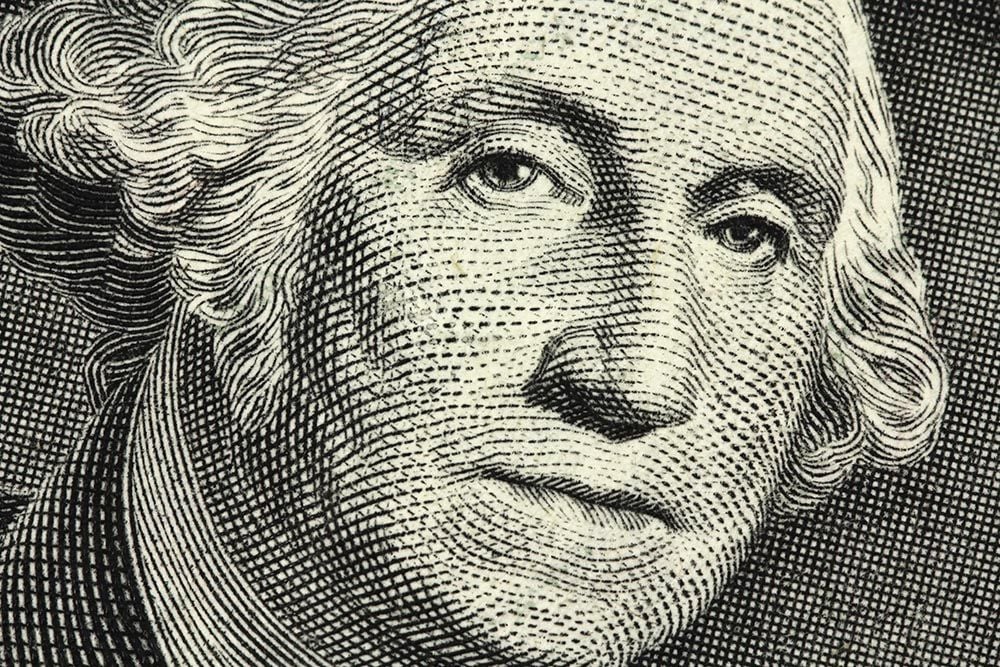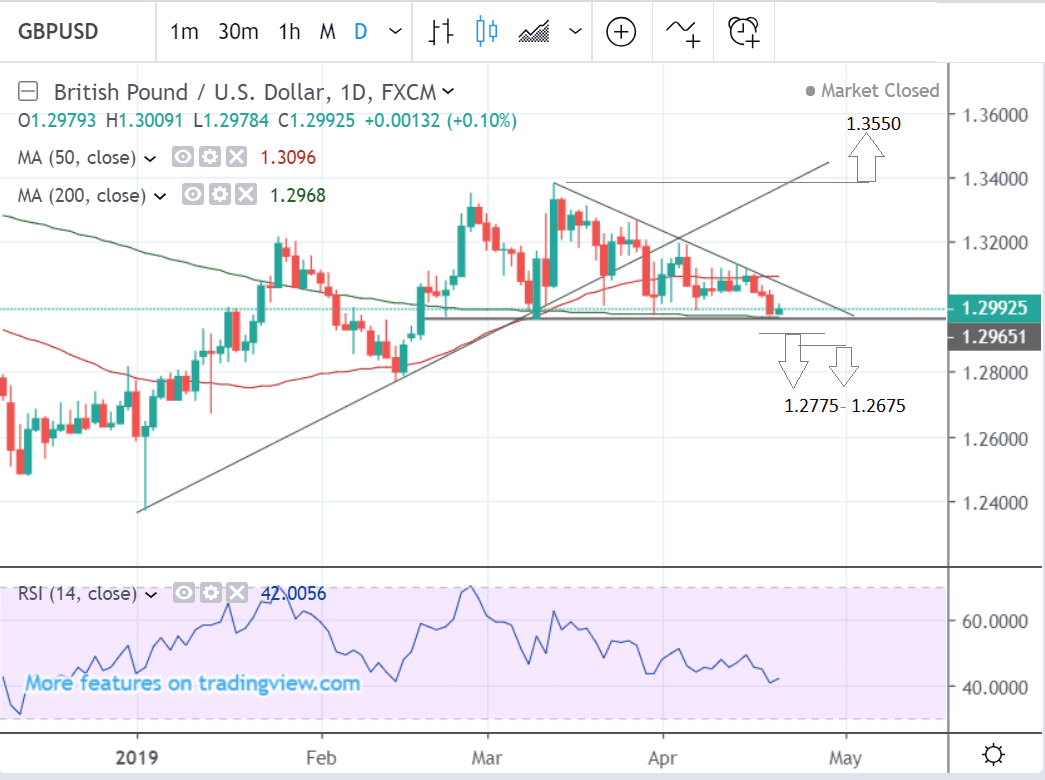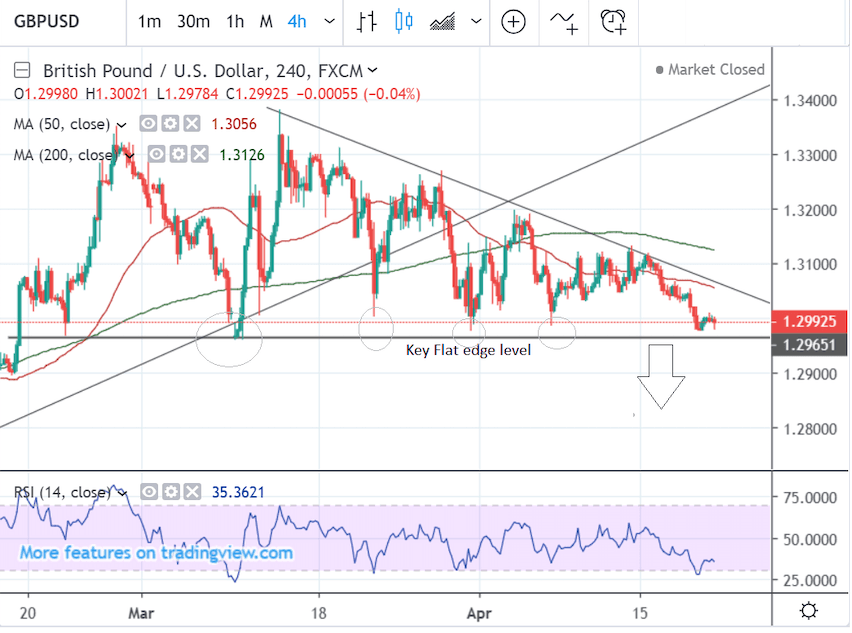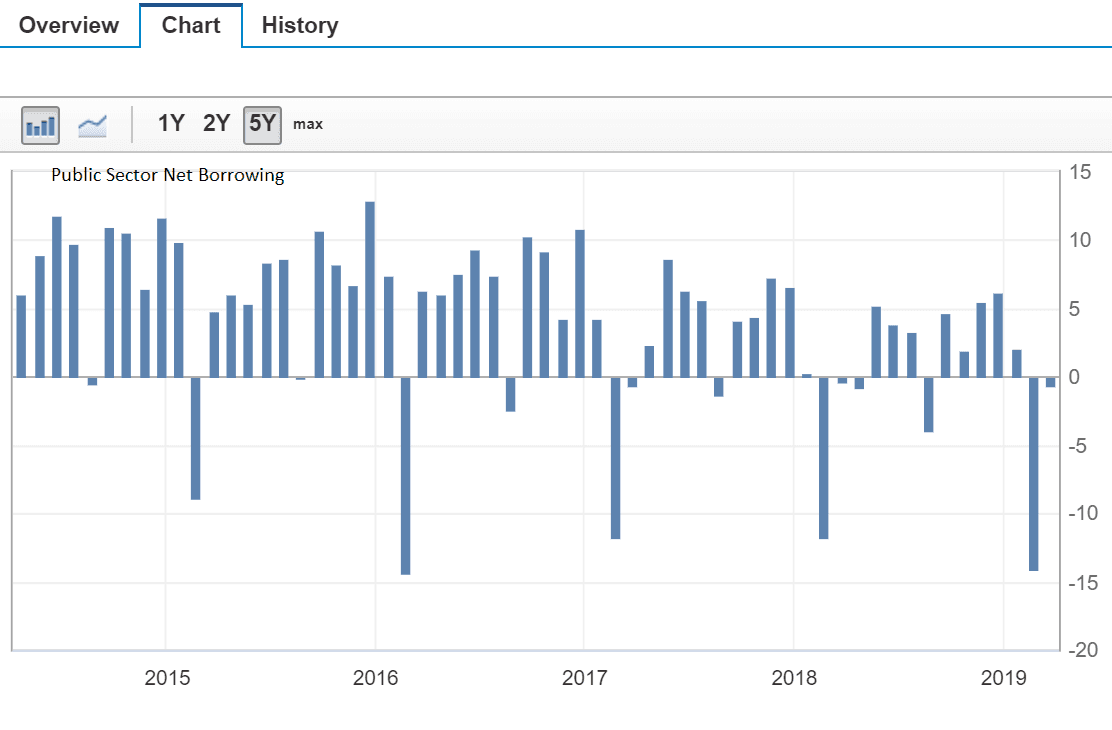Pound-to-Dollar Rate 5-Day Forecast: Neutral-to-Bearish as Exchange Rate Breaks Below 1.30

Image © Adobe Stock
- GBP/USD closes below 1.3000, a key rubicon
- Break below 200-day required for bears to get going
- May to be told she must exit office within weeks
- USD eyes GDP data release
The Pound-to-U.S. Dollar rate is trading at 1.2993 at the start of the new week, with holiday-thinned Monday trade ensuring currency markets are witnessing low volatility.
The exchange rate is however still about a half a percent lower than where it was a week ago, suggesting near-term momentum in GBP/USD is to the downside.
Most currencies saw limited movement in the run-up to Easter as many traders closed out their positions before the weekend.
Nevertheless, the Pound gained after the release of strong wage and retail sales data, but despite this, the Dollar rose more due to stronger U.S. data and doubts creeping in about the previously negative assessment of the U.S. economy.
It is now no longer the foregone conclusion that the Federal Reserve won’t hike this year.
From a technical perspective GBP/USD remains range bound and the outlook still neutral, although now with a marginal bearish bias.
GBP/USD would need to breach below the key 1.2960 March 11 lows for a more bearish signal to dominate.
The price patterning suggests a slight bias to more weakness rather than strength. The pair appears to have formed a neckline at around the 1.2970-1.3000 level and when we see these sorts of clear lines of support or resistance on a chart along with repeated attempts by price to batter through them, it is often a sign they will eventually give way.
The break below 1.3000 is also a negative sign as it is a key psychological level. Why? Because many traders will have placed their stops there and decided a move below is a signal to get out of their long positions. This could result in a surge of supply at this level and a domino effect down.
We have already discussed the importance of the March 11 lows, likewise a break above the March 13 highs would probably provide the necessary confirmation for an extension up to the next bullish target at 1.3550, which is a strong resistance level made up of a combination of both the 200-week MA and the R2 monthly pivot.
Returning to the bearish case, we might even say that a fall below the March lows would be the initial requirement for a more bearish outlook but even that might not be sufficient to really open the ‘sluice gates’ lower.
The problem remains the 200-day moving average (MA) which sits at 1.2975 and remains a hefty obstacle to downside development. Ideally, we would wish to see a break - not just below 1.2960 - but also below 1.2925, for clear confirmation the 200-day was breached.
How much further lower might such a move be expected to go following a break below that? We would say probably down to 1.2775 initially and the February lows followed by 1.2675 and the mid-January lows.
Time to move your money? Get 3-5% more currency than your bank would offer by using the services of foreign exchange specialists at RationalFX. A specialist broker can deliver you an exchange rate closer to the real market rate, thereby saving you substantial quantities of currency. Find out more here.
* Advertisement
The U.S. Dollar: What to Watch this Week
The main release in the week ahead for the U.S. Dollar is Q1 GDP data. This is the preliminary estimate for growth in Q1 so it is a big deal. It is probably also the main release for financial markets as a whole, period.
Official estimates are for growth in the U.S. to have risen by an annualised 1.8% compared to the previous quarter (annualised means taking the quarter-on-quarter change and extrapolating it to reflect what it would look like over a whole year). This would be slower than the 2.2% previously.
The main risk is that the actual figure will be higher-than-expected, however, and this will start to dispel widespread notions the U.S. economy is in decline and revive the idea the Federal Reserve (Fed) might raise interest rates in 2019. Such an outcome would be beneficial for the Dollar.
U.S. data could be characterised as being mixed to improving recently so GDP could be a big deciding factor.
Over the last two weeks factory orders, inflation, retail sales, the trade balance and jobless claims all came out better than expected; whilst housing, PMIs and industrial production undershot expectations. A lot, therefore, hinges on the GDP as a sort of deciding factor to either ‘seal the deal’ on the U.S. rebound or leave the jury out.
The stronger trade data in Q1 is going to be a major positive boost to Q1 GDP.
“For now however, trade is on track to provide a sizeable boost to GDP growth in the first quarter. According to our latest tally, net exports will add about 0.7 percentage points to the annualised rate of GDP growth in the first quarter before becoming a drag in the second quarter,” says Wells Fargo.
The bank thinks the market is being overly pessimistic forecasting only a 1.8% rise, and their own economists forecast a much higher 2.6% figure, which would actually be a greater than the 2.2% of the previous quarter.
As an aside, this would also support the slight bearish tilt to the technicals now the 1.3000 level has been breached.
Other data out of the U.S is unlikely to be as market moving as GDP. It includes, Existing home sales on Monday at 15.00, which is forecast to fall by -2.3% after the very solid 11.8% gain in the previous month of February.
Housing has been one of the weaker spots in the U.S economy and data last week was not particularly positive after it showed continued declines in both housing starts and building permits despite analysts expecting the opposite.
Yet Wells Fargo is also optimistic about existing home sales, arguing that the Fed’s fairly gentle rate hike trajectory and the strong jobs market has kept mortgage applications buoyant, and therefore is likely to translate into positive sales figures.
“Underlying demand continues to be solid, marked by low unemployment and rising wages. As the Fed maintains a more dovish monetary policy stance, mortgage rates continue to track lower, which has induced a steady rise in mortgage purchase applications. Overall, existing home sales appear set for modest improvement this year compared to relatively sluggish activity experienced throughout much of 2018,” says Wells Fargo.
Another major release out of the U.S. is durable goods orders which is expected to show a -1.6% fall compared to the previous month of February when it is released at 13.30 on Thursday. This partly due to a fall in Boeing 737 Max aircraft exports due to a technical fault.
This is likely to cause a drag in the data released next week. It is unlikely to affect the Dollar much, however, if it is primarily due to a single issue rather than part of an economic trend.
The Pound: What to Watch this Week
Politics is back on the agenda for Sterling as UK parliamentarians return to their desks.
A top member of Prime Minister Theresa May's Conservative Party will tell her in the coming week that she must step down by the end of June or her lawmakers will try again to depose her, the Sunday Times reported, without citing sources.
The pressure on May comes amidst a precipitous drop in support for the Conservative party after a lengthy Brexit delay was announced, with voters apparently flocking to the newly-formed Brexit Party of Nigel Farage. We see the implications of the sudden shift in domestic politics as posing downside risks to Sterling with a 'Brexit at all costs' likely to come on October 31.
The Conservatives, under May or a new leader, know further delays will only deeply damage the party's standing with the public.
A change in leader of the Conservatives could mean the UK could be under the leadership of a 'Brexiteer' Prime Minister by late summer, we believe this creates the kind of uncertainty that would weigh on Sterling over coming weeks and months.
According to the report, the Conservative Party could go as far as changing party rules on leadership change.
May survived a vote of no confidence in December with current party rules stating parliamentarians cannot challenge her again until a year has passed. Graham Brady - who oversees party rules - will tell May the rules will be changed unless she quits, the Sunday Times reports.
There is also the chance of a vote being held on whether the UK should remain in a customs union, which could cause a surge higher for Sterling if affirmative.
It is a thin week for UK data with the most important releases being the UK public borrowing data and figures from the Consortium of British Industry (CBI), which is often a useful leading indicator for the broader economy.
UK public borrowing basically measures how much the government needs to borrow to meet its outgoings in the month in question. The data on Tuesday is forecast to show a relatively small £50m (£0.05bn) sum was required to cover the shortfall.
The chart below shows how over time the government has reduced the amount it has needed to borrow to cover its outgoings. This is obviously a positive sign for the economy, both because it reduces the country’s reliance on outside lenders which can leave its currency more vulnerable, and also because it suggests the economy is generating more tax revenue, which is a sign of increased activity.
Public sector borrowing is not likely to move Sterling unless it surprises grossly higher or lower. Nevertheless, it provides useful background information. It is released at 9.30 BST.
The other key releases for the Pound are the CBI distributive trades and CBI industrial trends orders reports.
The former is a gauge of the “wellbeing of the retail sector” based on a survey of 150 retailers; the latter is a survey of manufacturers.
Both are considered important leading indicators and can impact on the Pound if the actual result differs substantially from the expected.
There is no official forecast for the retail survey which came out at -18 in March, but there is an official forecast for the manufacturing one, which is forecast to rise marginally to a balance of 2 from 1 in the previous month of March. The balance reflects the difference between positive and negative responses.
Time to move your money? Get 3-5% more currency than your bank would offer by using the services of foreign exchange specialists at RationalFX. A specialist broker can deliver you an exchange rate closer to the real market rate, thereby saving you substantial quantities of currency. Find out more here.
* Advertisement







